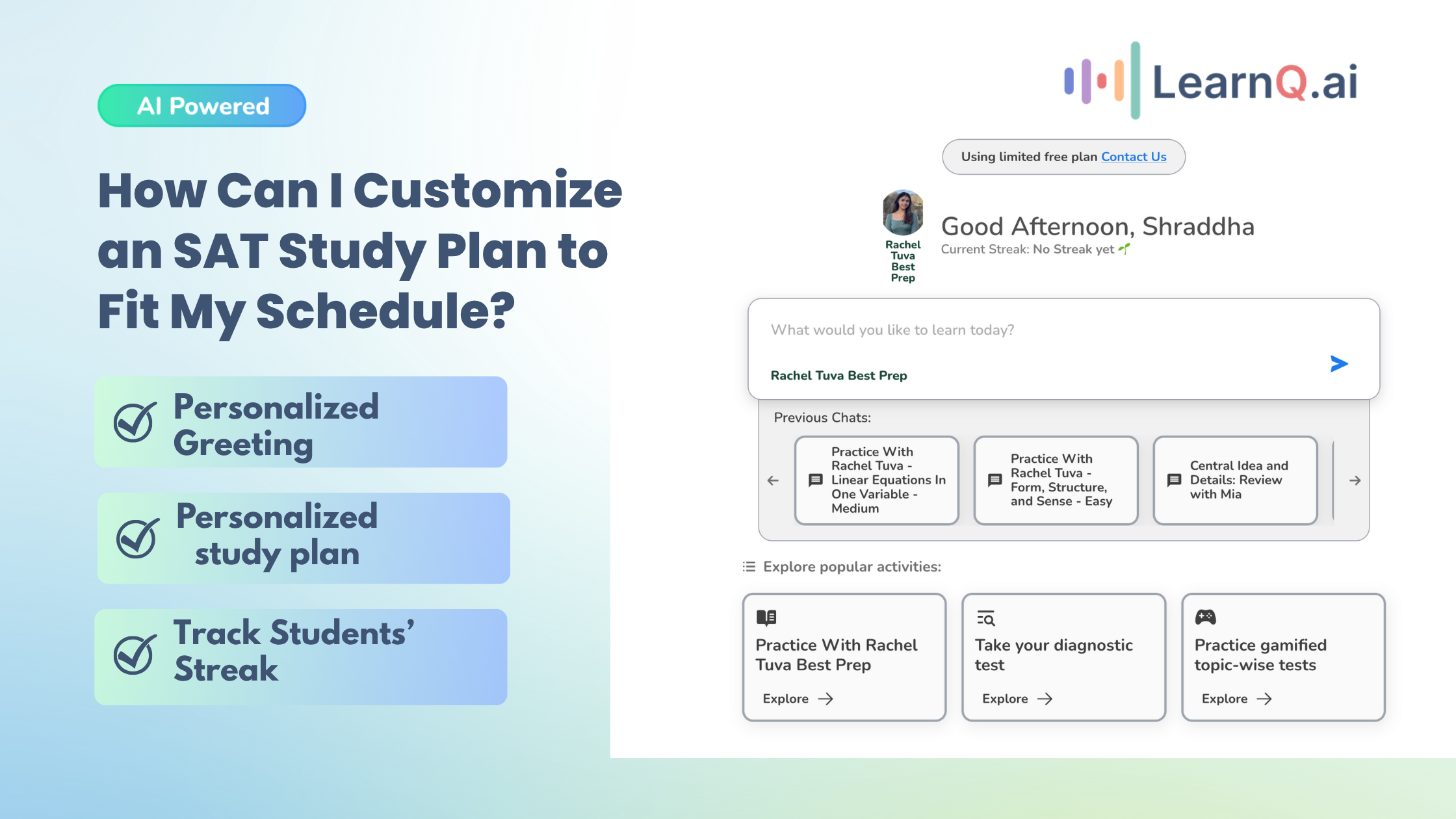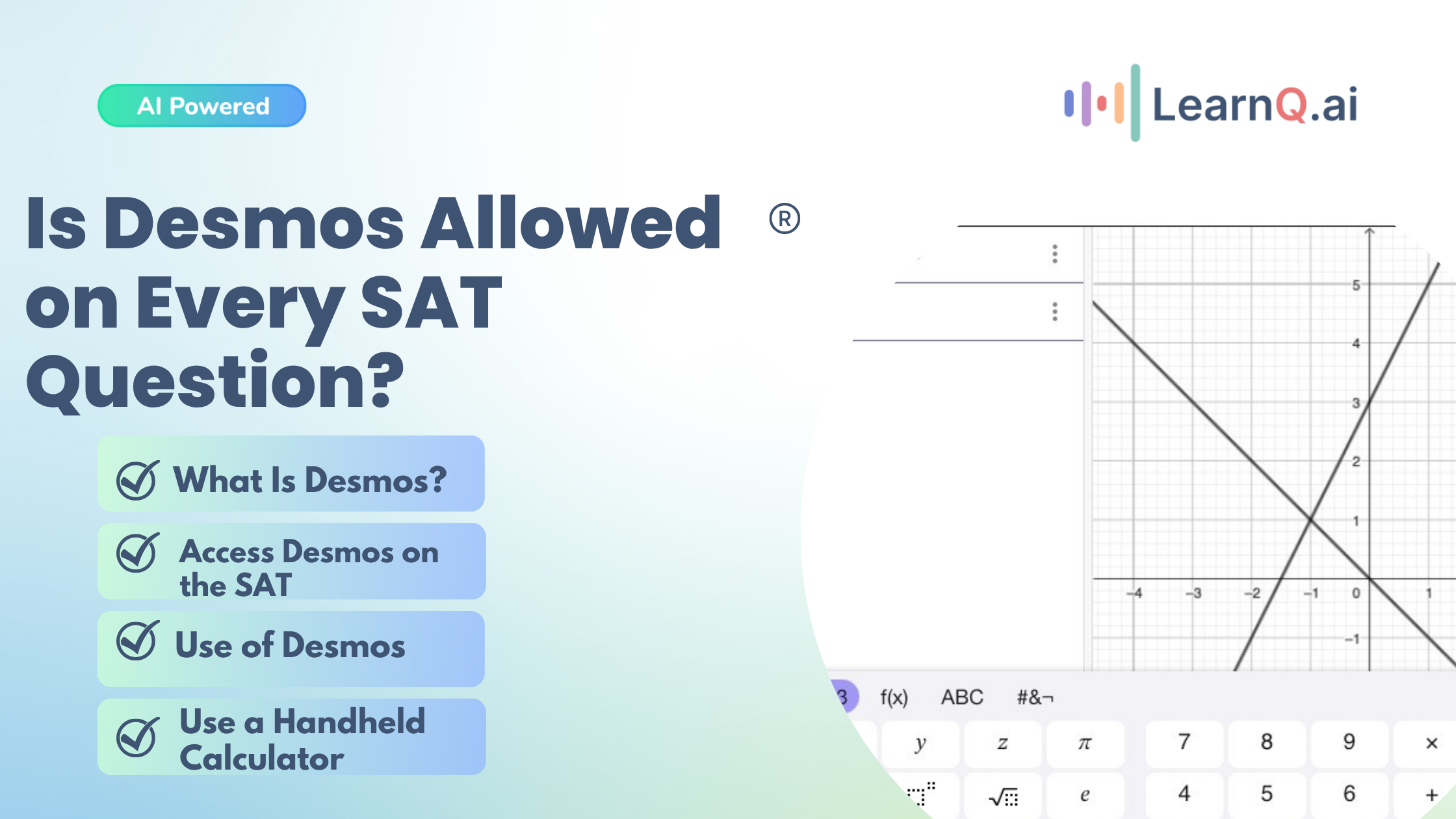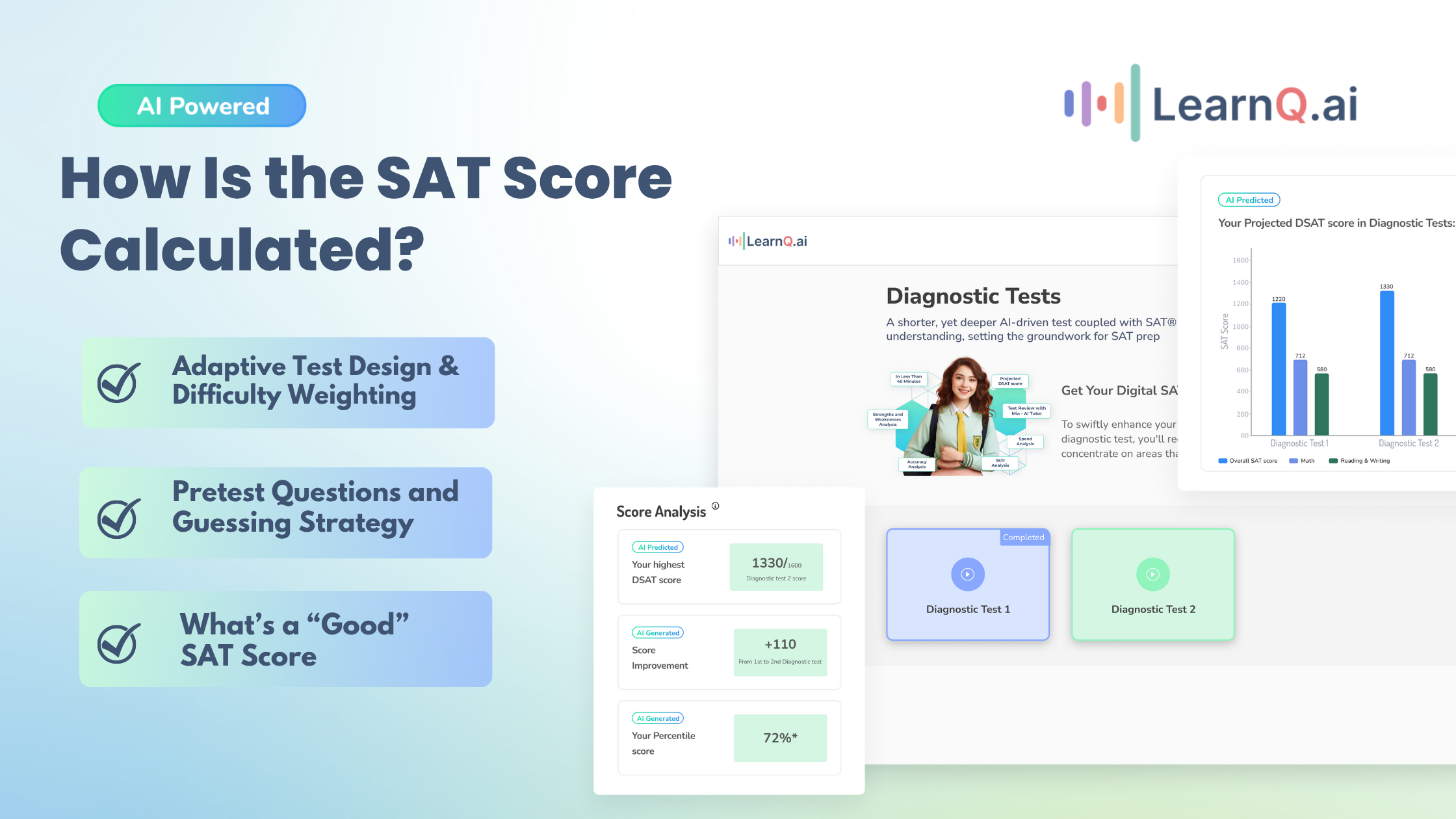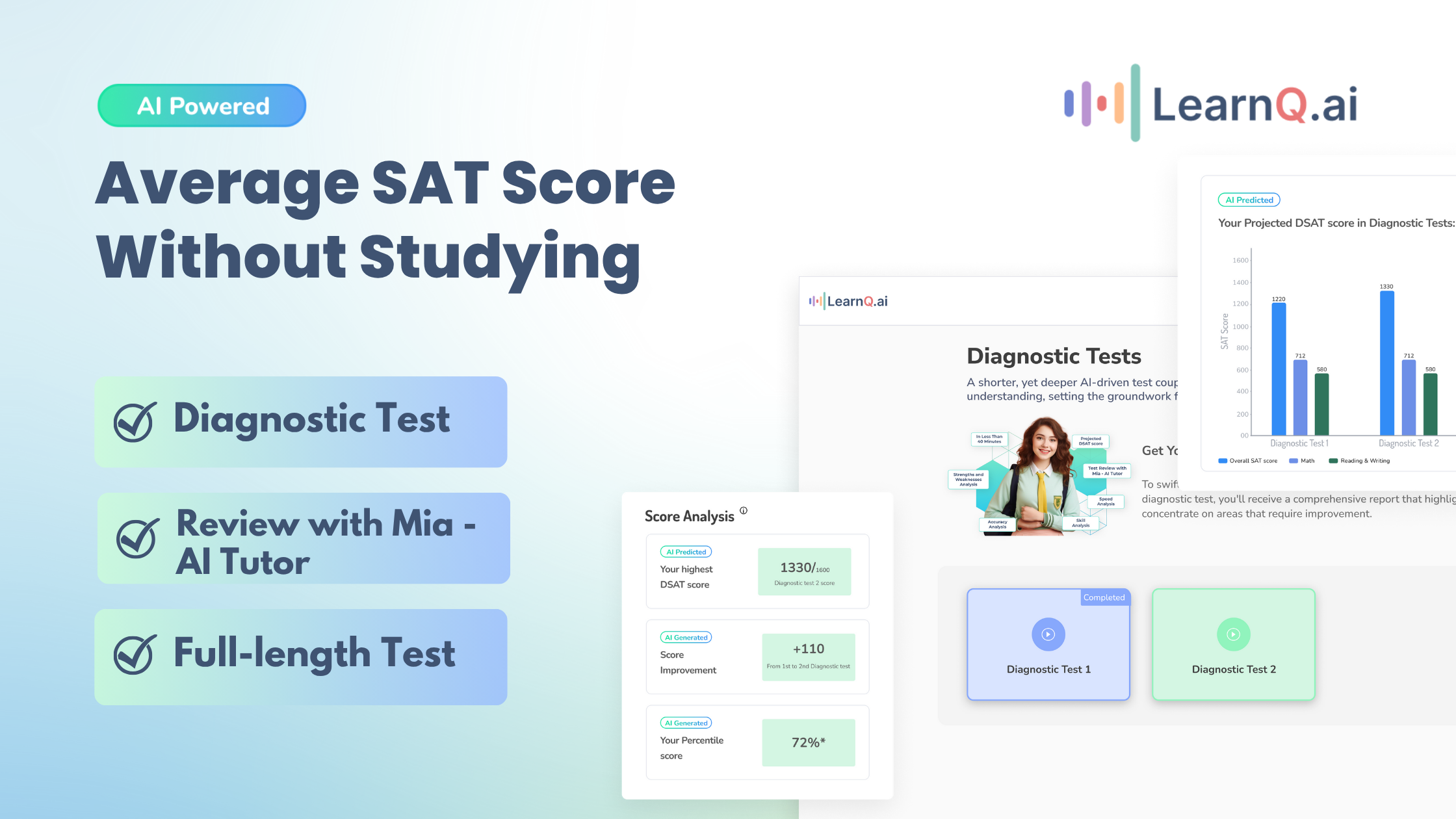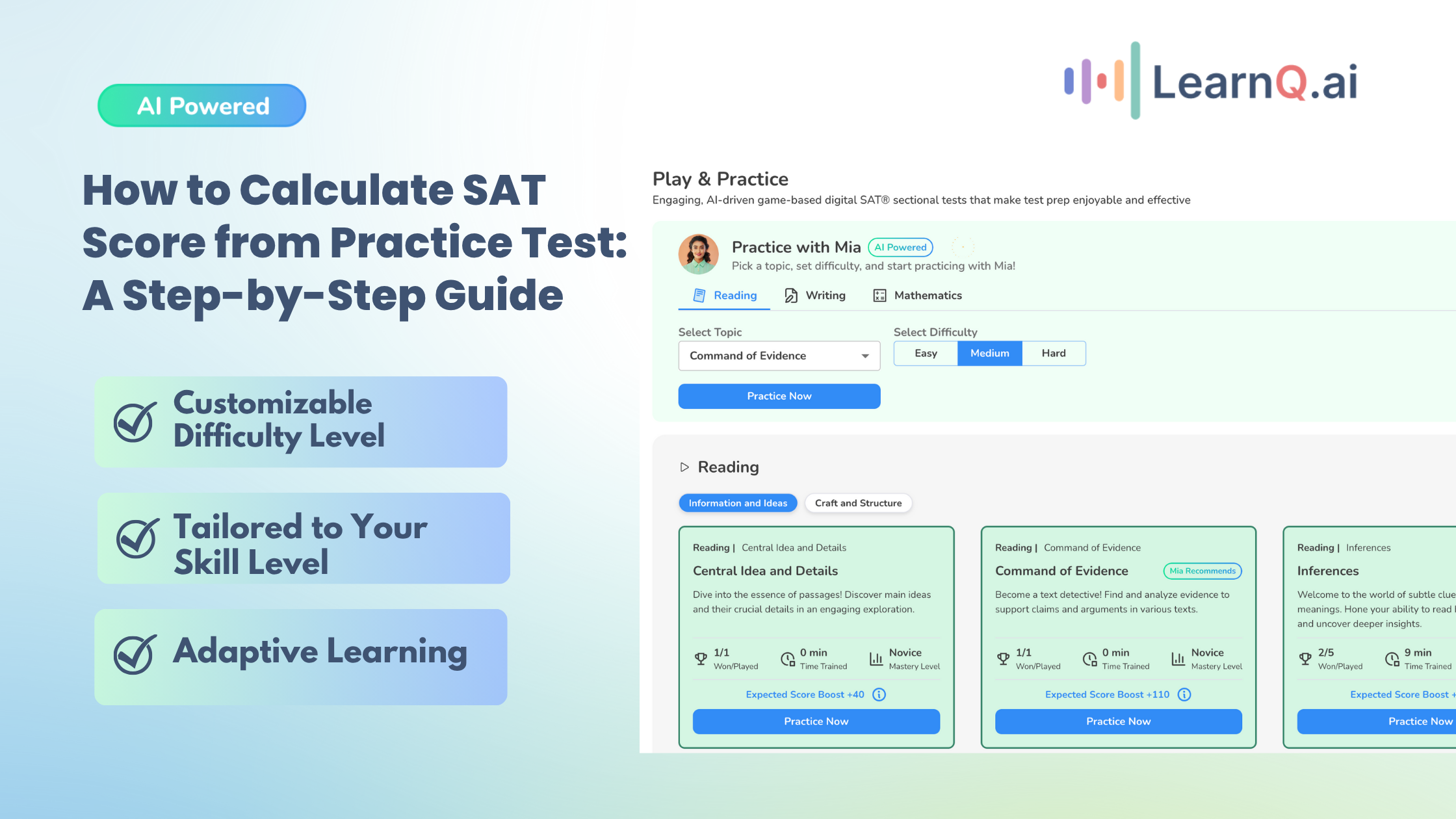The SAT has gone through a digital revolution, and are you ready?
Statistics show a significant shift towards the digital format, with over 60% of test-takers in 2023 opting for the computer-based version. This transition may leave you feeling apprehensive. After all, conquering a standardised test requires strategic preparation.
But fret not, future scholar! Here’s where a high-quality Digital SAT Question Bank becomes your secret weapon.
Think of it as your personalised training ground, packed with the tools and challenges you need to excel on the big day. However, with a plethora of options available, how do you identify the question bank that elevates your prep from good to great?
Let’s get into the key features and their importance in prepping for the SAT exam.
The significance of a Digital SAT Question Bank in preparing for the SAT exam
A Digital SAT Question Bank is a crucial tool for students preparing for the SAT exam, offering several significant benefits that enhance the overall preparation process. Here are some of the important significance of it:
- Comprehensive Coverage
A well-structured question bank covers all the sections of the SAT, including Reading, Writing, and Math. This comprehensive coverage ensures that students can practice questions from every domain, making their preparation holistic and thorough.
- Realistic Practice
Digital question banks often simulate the actual test environment, providing students with a realistic practice experience. This helps them become familiar with the test format, timing, and question types, reducing anxiety and improving performance on the actual exam day.
- Adaptive Learning
SAT utilizes adaptive learning technology, which adjusts the difficulty of questions based on the student’s performance. This personalized approach helps identify strengths and weaknesses, allowing students to focus their efforts where they are needed most.
- Instant Feedback
Immediate feedback on practice questions is a significant advantage of digital question banks. Students can learn from their mistakes in real time, understand the rationale behind correct answers, and refine their strategies accordingly. This continuous loop of practice and feedback accelerates learning and retention.
- Flexible Access
Being digital, these question banks can be accessed anytime and anywhere, making it easier for students to integrate study sessions into their busy schedules. This flexibility ensures that learning can happen continuously, whether at home, during school breaks, or even on the go.
Overview of Features that Distinguish a High-Quality Digital SAT Question Bank
Not all digital question banks are created equal. Here are the features that distinguish a high-quality SAT question bank:
- Diverse Question Types
A high-quality question bank includes a wide variety of question types, mirroring those found on the SAT. Diversity in question types ensures comprehensive practice and familiarity with all possible formats.
- Detailed Explanations
Each question should be accompanied by detailed explanations for both correct and incorrect answers. This helps students understand the logic and methodology behind each solution, promoting deeper learning and comprehension.
- Customizable Practice
Top-tier practice tests like LearnQ.ai offer customizable practice sessions, allowing students to focus on specific sections or question types. This targeted practice is essential for addressing individual weaknesses and improving overall performance.
- Progress Tracking and Analytics
Advanced analytics and progress tracking features enable students to monitor their performance over time. These tools provide insights into areas of improvement, track progress towards goals, and help in adjusting study plans based on data-driven feedback.
- Integration with Study Plans
A seamless integration with personalized study plans ensures that the practice questions are aligned with the student’s preparation strategy. This alignment helps in maintaining a structured approach to studying and ensures that practice sessions are effective and efficient.
- Engaging and Interactive
To keep students motivated, high-quality question banks incorporate interactive elements such as gamified learning experiences and adaptive quizzes. These features make studying more engaging and enjoyable, helping students stay committed to their preparation.
Now, let’s see the details of how a digital SAT question bank is created, and what are the important factors that contribute to building a high-quality question bank.
Also Read, Digital SAT Book Study And Practice Guide
LearnQ.ai is Powered by VEGA AI—Is your Institute Next?
Give students a Duolingo-style test-prep platform with Shopify-level customization for tutors and institutes.
Creation of a Digital SAT Question Bank
Creating a Digital SAT Question Bank is a meticulous process that requires a blend of expertise, precision, and adaptability.
This comprehensive resource is essential for effective SAT preparation, ensuring that students have access to questions that truly reflect the challenges of the actual exam.
Let’s get into the crucial steps involved in creating a robust Digital SAT Question Bank by LearnQ.ai
- Involvement of Subject-Matter Experts in the Question Creation Process
The foundation of a high-quality question bank lies in the expertise of the individuals who create it.
At LearnQ.ai, subject-matter experts (SMEs) play a pivotal role in this process. These professionals have an in-depth understanding of the SAT curriculum and the specific skills it tests. Their involvement ensures that each question is not only accurate but also relevant to the current standards of the SAT.
SMEs at LearnQ.ai collaborate to develop questions that cover all sections of the SAT, including Reading, Writing, and Math. They craft questions that test a range of skills, including Information and Ideas, Craft and Structure, Expression of Ideas, Standard English Conventions, Algebra, Advanced Math, Problem-Solving and Data Analysis, Geometry and Trigonometry.
By using their expertise, SMEs create questions that challenge students at the right level and help them build the necessary skills for the exam.
- Ensuring the Questions Mimic the Format and Difficulty of the Actual Digital SAT
One of the key aspects of an effective question bank is its ability to mirror the format and difficulty of the actual exam. This involves more than just creating questions that are similar in content; it requires an understanding of the SAT’s structure and the way questions are presented.
At LearnQ.ai, the development team closely studies the latest SAT guidelines and sample tests provided by the College Board. They analyze the types of questions included in the exam, the common pitfalls students face, and the strategies required to answer them correctly.
This analysis informs the creation of questions that are not only similar in content but also in structure and complexity, ensuring that students receive realistic and relevant practice.
- The Adaptive Nature of the Digital SAT and Its Impact on LearnQ.ai’s Practice Sets Design
The Digital SAT introduces an adaptive testing element, which adjusts the difficulty of questions based on the student’s performance. This adaptive nature significantly impacts the design of the question bank.
LearnQ.ai’s question tests include a wide range of questions with varying levels of difficulty to accommodate this adaptive testing model. This ensures that as students progress through their preparation, they are presented with appropriately challenging questions, helping them to improve steadily.
As students practice, data is collected on their performance, which is used to refine and enhance the question bank. This iterative process ensures that the question bank remains relevant and effective, providing students with the best possible preparation for the Digital SAT.
By combining the rigorous processes and expert involvement in question creation with innovative adaptive technology, LearnQ.ai offers a comprehensive and effective SAT preparation tool that aligns closely with the demands of the actual exam.
Quality Assurance and Reliability at LearnQ.ai
Ensuring the reliability and accuracy of a Digital SAT Question Bank is paramount for effective SAT preparation. This involves meticulous processes and strict adherence to guidelines set by the College Board.
LearnQ.ai, with its advanced AI technology and rigorous quality control measures, exemplifies how to maintain high standards in this area.
Processes to Ensure Reliability and Accuracy of the Question Banks
Creating a reliable and accurate question bank involves several rigorous steps:
- Subject-Matter Expertise: Subject-matter experts (SMEs) are integral to the question creation process. These individuals at LearnQ.ai have deep knowledge of SAT content and pedagogy, ensuring that each question is relevant and challenging.
- Multiple Review Stages: Questions undergo multiple rounds of review. Initially, they are reviewed by SMEs to check for content accuracy and alignment with SAT standards. Subsequently, they are tested for clarity, bias, and fairness. LearnQ.ai ensures that every question is scrutinized thoroughly to maintain high quality.
- Pilot Testing: New questions are pilot-tested with a group of students to gather performance data. This data helps in understanding how students interpret and respond to the questions, ensuring that they function as intended in a real test scenario. LearnQ.ai’s pilot testing phase involves a diverse group of students to ensure comprehensive feedback.
- Statistical Analysis: After pilot testing, questions undergo statistical analysis to determine their difficulty level, discrimination index (ability to differentiate between high and low performers), and reliability. Questions that do not meet the required standards are revised or discarded. LearnQ.ai utilizes advanced analytics to refine and validate each question.
- Continuous Updates: The question bank is regularly updated to reflect changes in SAT content and format. This involves adding new questions and retiring outdated ones to maintain the relevance and accuracy of the question bank. LearnQ.ai ensures its question bank stays current by continuously incorporating feedback and adhering to the latest SAT guidelines. Utilization of Actual SAT Questions and Adherence to College Board Guidelines
Adhering to College Board guidelines is critical for creating an effective question bank. LearnQ.ai excels in this by strictly following these guidelines:
- Alignment with Official Standards: Questions are crafted to align with the SAT’s content domains and skill areas as outlined by the College Board. This ensures that the practice questions mirror the scope and depth of the actual exam. LearnQ.ai’s question bank is meticulously aligned with these standards to provide realistic practice.
- Use of Released SAT Questions: Incorporating released SAT questions into the question bank provides students with practice that is directly reflective of the types of questions they will encounter on the actual test. These released questions are sourced from the College Board’s official practice materials. LearnQ.ai includes these questions to offer the most authentic practice experience.
- Adherence to Test Specifications: The question bank is designed to meet the specifications provided by the College Board, including question format, timing, and scoring. This ensures that students get a realistic practice experience. LearnQ.ai’s platform mirrors these specifications to provide an accurate simulation of the SAT.
- Regular Review and Compliance Checks: Regular reviews and compliance checks are conducted to ensure that all questions meet the College Board’s guidelines. This includes verifying that the questions are up-to-date with the latest SAT changes and that they adhere to the College Board’s fairness and bias guidelines. LearnQ.ai conducts frequent audits to maintain compliance and uphold the highest standards.
Now that we’ve explored the essential elements involved in curating a high-quality digital SAT question bank, let’s move on to the next important aspect: the features you should expect from it.
Features of a High-Quality Practice Interface by LearnQ.ai
A high-quality practice interface should include several key features to enhance the realism and effectiveness of your practice sessions:
- Built-in Digital Timers and Tools to Review:
- You can practice under timed conditions that mirror the actual SAT exam, helping you build the stamina and pacing skills needed to complete the test within the allotted time.
- The “Mark for Review” feature is a valuable tool in digital SAT preparation platforms. It allows you to flag questions they are unsure about and revisit them later, ensuring a thorough and efficient approach to studying.
- Built-in Calculators:
- The SAT permits the use of the “Desmos calculator” for the entire math section.
- A built-in calculator within the practice interface ensures that you become familiar with the tools you’ll use on test day, reducing the likelihood of mistakes and improving your efficiency.
- Reference Sheets:
- Providing digital reference sheets within the practice interface helps you get used to the resources available during the exam.
- This familiarity can save you valuable time and ensure that you know where to find the information you need quickly.
- Adaptive Testing Features:
- An adaptive practice interface can adjust the difficulty of questions based on your performance, similar to the actual Digital SAT.
- This feature helps you get used to the adaptive nature of the test and allows you to practice at the appropriate level of difficulty.
- Detailed Feedback and Analytics:
- A good practice interface should provide detailed feedback on your performance, including analytics on your strengths and areas for improvement.
- This data-driven approach helps you track your progress and tailor your study plan to address your specific needs.
Time Management Strategies in Digital SATs
The Digital SAT (DSAT) throws time management challenges at you. LearnQ.ai can help you tackle those challenges by providing data-driven insights to optimize your time allocation per question.
Here’s how to leverage LearnQ.ai’s analytics alongside the suggested time allocation:
Suggested Time per Question:
- Reading & Writing: 71 seconds per question (64 minutes for 54 questions)
- Math: 95 seconds per question (70 minutes for 44 questions)
LearnQ Analytics Integration:
- Analyze Strengths & Weaknesses: Look at your LearnQ analytics to identify your strengths and weaknesses in each section (Reading, Writing, Math).
- Prioritize Accordingly: Knowing your strengths and weaknesses, adjust the suggested time allocation slightly. For example, if you perform consistently better in Reading compared to Writing, allocate a few extra seconds to Writing questions within the 71-second limit.
- Track Performance: After taking practice tests on LearnQ, review the analytics to see if you consistently met the time limits. If not, adjust your pacing during future practice tests.
Remember: These are suggested times – LearnQ.ai helps you find your optimal pace.
Additional Tips:
- Regular practice with LearnQ.ai’s adaptive tests will improve your speed and accuracy, allowing you to answer questions more efficiently.
- Don’t get stuck! If you can’t answer a question within the allocated time, flag it, move on, and come back to it later if time allows.
- Analyze your performance on practice tests to understand why you went overtime on certain questions. LearnQ.ai’s explanations can help you avoid similar mistakes on the actual exam.
By combining the suggested time allocation with personalized insights from LearnQ.ai’s analytics, you can develop a time management strategy that optimizes your performance on the Digital SAT.
Curious about SAT Score, Validity, and Total Marks? Read this blog!
Enhance your Digital SAT study routine with AI-driven insights and personalized practice tests.
Using Performance Tracking Tools to Identify and Improve Weak Areas
Identifying and improving weak areas is crucial for effective SAT preparation. Utilizing performance tracking tools can help you understand your strengths and weaknesses, enabling targeted improvement.
Here’s how to use these tools effectively:
- Leverage Digital Platforms:
- Use LearnQ.ai which offers detailed analytics on your performance. It provides insights into your strengths and weaknesses, helping you focus on areas that need improvement.
- Review Performance Data:
- After each practice test or study session, review your performance data on LearnQ.ai’s comprehensive dashboard. Look at the time spent on each question and identify patterns where you may be consistently slow or making errors.
- Customize Study Plans:
- Based on the data, a customized study plan will also be created by LearnQ.ai’s AI tutor Mia, that targets your weak areas. Allocate more time to practising these types of questions and work on improving your speed and accuracy.
- Set Specific Improvement Goals:
- Set specific, measurable goals for each study session. For example, aim to reduce the average time spent on math questions by 10% over the next month or improve accuracy in the reading section by 5%.
Now that you have already learned to use tools, and manage time in a a test, let’s see how can you try to improve your score post-test.
Post-Test Analysis and Improvement
Effective post-test analysis is crucial for continuous improvement in SAT preparation. Providing detailed answer explanations and comprehensive scoring, analytics, and feedback can significantly enhance a student’s learning experience and performance.
LearnQ.ai exemplifies these practices, offering robust tools and features that support thorough post-test analysis.
Providing Detailed Answer Explanations to Foster Learning and Improvement
Detailed answer explanations are essential for helping you understand the reasoning behind each answer, which fosters deeper learning and improvement.
Here’s why they matter:
- Clarification of Concepts: Detailed explanations break down the logic and steps required to arrive at the correct answer. This helps clarify any misunderstandings and reinforces key concepts. LearnQ.ai provides comprehensive explanations for each question with AI tutor Mia, ensuring that you grasp the underlying concepts and strategies needed for the SAT.
- Learning from Mistakes: By reviewing why an answer was incorrect, you can identify your thought process errors and learn how to approach similar questions differently in the future. LearnQ.ai’s explanations highlight common pitfalls and guide you on how to avoid them.
- Enhanced Retention: Explanations that connect the question to broader concepts can help you remember the material better. This connection between specific questions and overarching ideas aids in long-term retention. LearnQ.ai ensures that explanations link questions to key concepts, enhancing memory retention.
- Building Confidence: Understanding the rationale behind correct answers can boost your confidence, making you more prepared and less anxious for future tests. By providing clear and thorough explanations with the help of AI tutor Mia, LearnQ.ai helps build your confidence.

Offering Scoring, Analytics, and Feedback to Help Students Gauge Their Performance
Providing detailed scoring, analytics, and feedback is vital for helping students track their progress and identify areas for improvement.
Here’s how these tools contribute to effective SAT preparation:
- Performance Tracking: Detailed scoring allows students to see their scores for each section and overall performance. This helps them understand their strengths and weaknesses. LearnQ.ai offers comprehensive scoring that gives students a clear view of their performance.
- Data-Driven Insights: Analytics can show patterns in a student’s performance, such as which types of questions they frequently miss or which sections they excel in. This data helps tailor study plans to address specific needs. LearnQ.ai’s analytics provide deep insights into performance patterns, helping students and educators identify areas for improvement.
- Targeted Feedback: Personalized feedback based on performance data provides actionable insights. For example, if a student consistently struggles with algebra questions, targeted feedback might suggest additional practice in that area or recommend specific resources. LearnQ.ai uses performance data to generate targeted feedback, guiding students on where to focus their efforts.
- Progress Monitoring: Regular feedback on practice tests allows students to monitor their improvement over time. This ongoing assessment helps keep them motivated and focused on their goals. LearnQ.ai’s platform includes tools for continuous progress monitoring, ensuring students stay on track.
Also Read, Top Strategies And Digital PSAT Tips For Better Preparation
Optimal Preparation Timing
When it comes to preparing for the SAT, timing is everything. Starting early and maintaining consistent practice are key factors that contribute to achieving a high score.
Let’s explore the recommended timeframe for starting your SAT preparation using a question bank and the importance of consistency in practice.
1. Recommended Timeframe for Starting SAT Preparation Using a Question Bank
Starting your SAT preparation early is crucial for thorough and effective study. Here’s a suggested timeline to help you plan your prep:
- Junior Year Start: It’s advisable to begin your SAT preparation at the start of your junior year in high school. This gives you ample time to cover all the necessary material without feeling rushed. Starting this early allows for a more relaxed study pace, reducing stress and improving retention.
- Six Months to One Year in Advance: Ideally, you should begin intensive preparation using a question bank at least six months to one year before your planned test date. This timeframe allows for thorough coverage of all topics, plenty of practice tests, and the opportunity to address any weaknesses.
- Consistent Weekly Practice: Aim to incorporate SAT practice into your weekly routine. Dedicate specific days and times to focus on different sections of the test. Consistent weekly practice helps build and reinforce skills over time.
2. Advice on Consistency in Practice for Continuous Improvement
Consistency is a critical component of successful SAT preparation. Here’s how to maintain a consistent practice schedule for continuous improvement:
- Create a Study Schedule: Develop a detailed study schedule that outlines your daily and weekly study goals. Break down your study sessions into manageable chunks, focusing on different sections and question types each time. Consistency in your study schedule ensures steady progress.
- Daily Practice: Integrate SAT practice into your daily routine. Even short, daily practice sessions can be highly effective. For example, spending 20-30 minutes each day on practice questions can lead to significant improvements over time.
- Regular Full-Length Practice Tests: Take full-length practice tests regularly, such as once a month, to simulate the actual test environment. These practice tests help you gauge your progress, identify areas that need more work, and build stamina for test day.
- Track Your Progress: Use performance tracking tools provided by LearnQ.ai. These tools can help you monitor your improvement over time, highlight your strengths and weaknesses, and adjust your study plan accordingly.
- Review and Reflect: After each practice session, review your answers, especially the ones you got wrong. Understand why you made mistakes and how to avoid them in the future. Reflection and review are essential for continuous improvement.
Also Read, What’s The Best Time To Start Prep For SAT? Your Guide To Planning?
LearnQ.ai is powered by VEGA AI—Is your institute next?
Offer students a Duolingo-style test-prep platform with Shopify-level customization for tutors and institutes.






Conclusion
Creating and utilizing a high-quality digital SAT question bank is essential for effective preparation. The process involves the expertise of subject-matter experts, the creation of questions that mirror the actual SAT in format and difficulty, and the incorporation of adaptive testing elements to cater to individual learning needs.
These elements ensure that you receive realistic, challenging, and relevant practice, which is crucial for achieving a high score on the SAT.
In 2024, leveraging advanced technology like LearnQ.ai can significantly enhance your SAT prep experience. LearnQ.ai offers a comprehensive and adaptive question bank, built by experts and continuously updated to reflect the latest SAT standards.
With features like built-in digital timers, detailed answer explanations, and performance tracking tools, LearnQ.ai provides a personalized and efficient study experience.
By integrating the strengths of traditional methods with innovative AI-driven tools, LearnQ.ai ensures that you are not only well-prepared but also confident and ready to excel on the Digital SAT.
Embrace the future of SAT preparation with LearnQ.ai and maximize your potential to achieve your best score.


